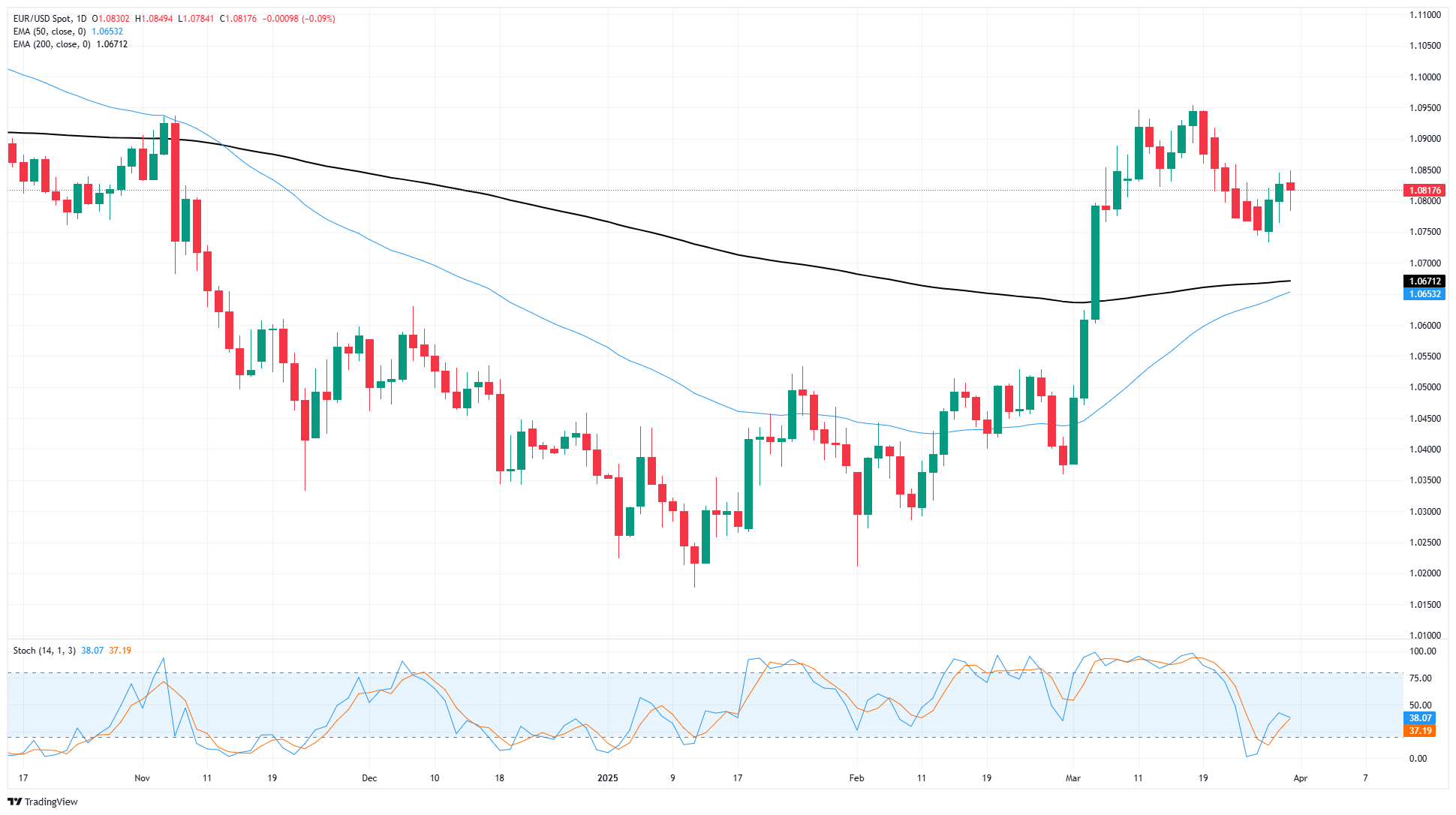EUR/USD holds steady ahead of this week’s tariff showdown
- EUR/USD churned the charts near 1.0850 on Monday.
- Markets are drawing into the midrange as investors await Trump tariffs.
- European inflation update due on Wednesday, US NFP labor data dump on Friday.
EUR/USD flubbed a bullish run at the 1.0850 level on Monday, kicking off the new trading week on decidedly tepid footing. Investors are preparing for the newest round of tariff threats from US President Donald Trump. The Trump administration plans to implement a broad range of tariffs affecting nearly all of the US’s trading partners starting April 2. While the specific details of these tariff strategies remain unclear, major threats include “reciprocal” tariffs on any country that imposes its own import tariffs on US products, irrespective of the economic situation. Additional retaliatory tariffs on Canada and the European Union are also anticipated, alongside proposed blanket tariffs on copper and automobiles.
European inflation figures will be updated this week, with preliminary Harmonized Index of Consumer Prices (HICP) inflation slated for a Wednesday release. Not much change is expected on the pan-EU inflation front, with price pressures remaining stubbornly stable but delivering few surprises in 2025.
On the American side, a fresh print of US Nonfarm Payrolls (NFP) labor figures are due later this week. This NFP release could be a major datapoint for markets as the US economy heads into a post-tariff economic environment, with March’s labor data set to act as a “bellwether” for the impacts of the Trump team’s tariff plans.
EUR/USD price forecast
EUR/USD continues to trade in the middle of a technical trap, with buyers unable to take a firm leg higher, but short pressure too limited to push Fiber price action back under the 200-day Exponential Moving Average (EMA) just south of the 1.0700 handle.
EUR/USD snapped a near-term losing streak, pushing technical oscillators into oversold territory, but a continuation pattern remains unlikely as market participants focus on geopolitical factors.
EUR/USD daily chart
Euro FAQs
The Euro is the currency for the 19 European Union countries that belong to the Eurozone. It is the second most heavily traded currency in the world behind the US Dollar. In 2022, it accounted for 31% of all foreign exchange transactions, with an average daily turnover of over $2.2 trillion a day. EUR/USD is the most heavily traded currency pair in the world, accounting for an estimated 30% off all transactions, followed by EUR/JPY (4%), EUR/GBP (3%) and EUR/AUD (2%).
The European Central Bank (ECB) in Frankfurt, Germany, is the reserve bank for the Eurozone. The ECB sets interest rates and manages monetary policy. The ECB’s primary mandate is to maintain price stability, which means either controlling inflation or stimulating growth. Its primary tool is the raising or lowering of interest rates. Relatively high interest rates – or the expectation of higher rates – will usually benefit the Euro and vice versa. The ECB Governing Council makes monetary policy decisions at meetings held eight times a year. Decisions are made by heads of the Eurozone national banks and six permanent members, including the President of the ECB, Christine Lagarde.
Eurozone inflation data, measured by the Harmonized Index of Consumer Prices (HICP), is an important econometric for the Euro. If inflation rises more than expected, especially if above the ECB’s 2% target, it obliges the ECB to raise interest rates to bring it back under control. Relatively high interest rates compared to its counterparts will usually benefit the Euro, as it makes the region more attractive as a place for global investors to park their money.
Data releases gauge the health of the economy and can impact on the Euro. Indicators such as GDP, Manufacturing and Services PMIs, employment, and consumer sentiment surveys can all influence the direction of the single currency. A strong economy is good for the Euro. Not only does it attract more foreign investment but it may encourage the ECB to put up interest rates, which will directly strengthen the Euro. Otherwise, if economic data is weak, the Euro is likely to fall. Economic data for the four largest economies in the euro area (Germany, France, Italy and Spain) are especially significant, as they account for 75% of the Eurozone’s economy.
Another significant data release for the Euro is the Trade Balance. This indicator measures the difference between what a country earns from its exports and what it spends on imports over a given period. If a country produces highly sought after exports then its currency will gain in value purely from the extra demand created from foreign buyers seeking to purchase these goods. Therefore, a positive net Trade Balance strengthens a currency and vice versa for a negative balance.


